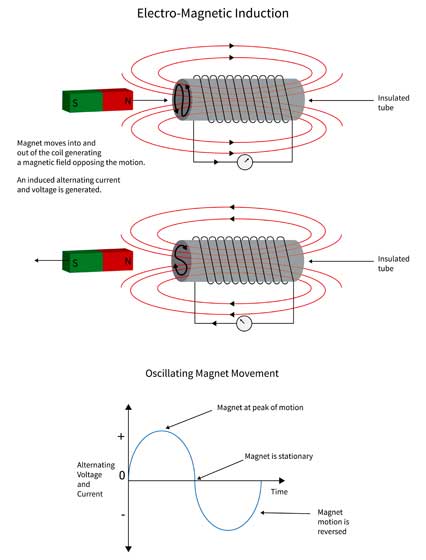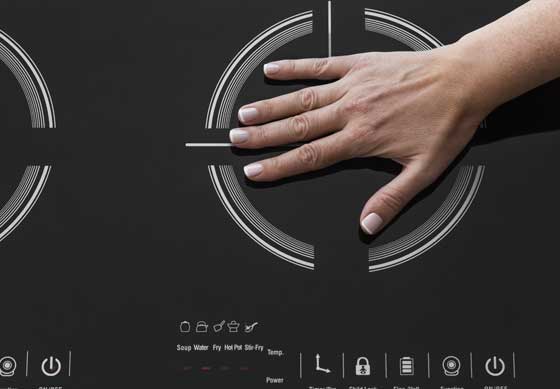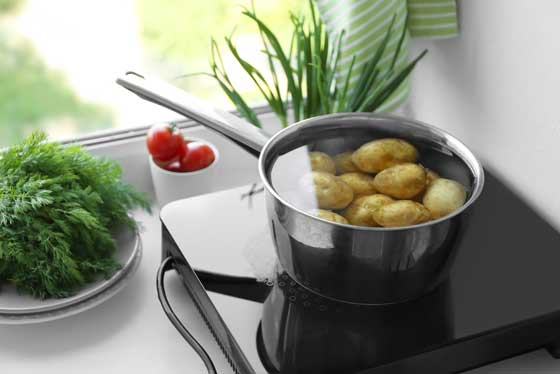Pros and Cons of Induction Cooktop Technology
While induction cooking technology offers a wide range of advantages, there are some drawbacks, as well as some significant differences to cooking with gas or electric. To make an informed decision you should have a good understanding of benefits and also disadvantages of this technology. In this section, we’ll help you sort through the benefits and drawbacks.
Benefits
- Much more energy efficient than electric or gas cooktops
- At least 50% faster than gas and electric cooktops
- Safe in households with small children who might accidentally touch the cooktop
- Instant control over heat level
- Most have a built-in sensor that tells when a vessel is on the eye, so leaving the unit on wastes less power
- Easy to clean and care for as anything dropped or spilled on the surface will not bake on
- Portable induction cooktops are very cheap and versatile additions
What you should know
- Only cast iron or steel/stainless steel cookware can be used; cannot use glass, copper or aluminum
- A whirring noise is sometimes heard while cooking (normal operation) Check our FAQ's for more
- Installation may be more in depth for in-built models than with a conventional type of cooktop
- Built-in models may more expensive than conventional gas or electric options
Why is Induction Different?
Induction cooktop vs electric and gas
Both gas and electric cooktops rely on creating heat outside of the cooking vessel, and then transferring that heat into the pot or pan you’re using, and then into the food.
Induction cooking technology is different.
 Induction technology creates heat within the pan, not in the eye of the cooktop.
Induction technology creates heat within the pan, not in the eye of the cooktop.
Older cooktop technology is pretty simple to understand.
A gas stove is perhaps the simplest. Each eye connects to the gas line, and turning it on and using the igniter creates a flame that heats anything you place on top of the eye.
Electric cooktops are slightly more complicated, but still relatively simple. An electric current is run through each burner, which is made from a metal that resists the flow of electrons. This resistance is what causes the eye to heat up. It’s pretty similar to how an old-fashioned incandescent light bulb works.
Whereas each eye on an induction cooktop consists of 2 parts. There’s a ceramic plate at the top and underneath that you’ll find an electromagnet, which is just a magnet with an electrical coil wrapped around it.
When you turn on the eye an electric current passes through the coil. This creates a fluctuating magnetic field. If you place your hand on top of the eye, it feels cool to the touch.
However if you place a piece of iron or steel on the eye, it quickly heats up. This is because the magnetic field induces a series of electric charges in the metal. Remove the metal and put your hand back on the eye, and it’s still cool.
 The beauty of this system is it’s safer for you and your family.
The beauty of this system is it’s safer for you and your family.
You never need worry that a small child will inadvertently put their hand on a hot eye after you’ve moved the pot out of the way. It also dramatically reduces the chance of fire, as grease and cooking debris that land on the cooktop will cool, rather than be subjected to even more heat.
There’s a range of benefits with induction cooktops that you can’t get anywhere else. These include the following:
- Enhanced Safety: It remains one of the single most common reasons for homeowners to investigate induction technology in the first place.
- Faster Performance: An induction cooktop can boil water in a pot in less than half the time it takes on an electric or gas cooktop, speeding up your cooking times significantly.
- More Energy Efficient: An induction cooktop uses far less energy than an electric cooktop, or the equivalent for a gas cooktop.
Given the growing importance of and focus on reducing our carbon footprint in an effort to be better environmental stewards, let’s take a look at the improved efficiency offered by induction technology.
Built-In and Portable Induction Cooktops
Take a quick look at the market you’ll find a wide range of induction cooktop options. They can largely be divided into built-in cooktops and portable cooktops. Built-in cooktops are similar to the traditional gas or electric stove that you grew up with. They’re built into the unit itself, or the counter.
Portable induction cooktops are precisely as the name implies. Smaller units that can be used pretty much anywhere, and don’t require a permanent location.
However within these 2 categories you’ll find a host of subcategories. It’s important to understand these as they apply directly to your purchase decision.
These are designed specifically so your cooktop can be moved easily and transported without hassle. They can be placed anywhere that you want to cook which makes them ideal for small living areas. Portable cooktops can be taken with you when you travel. And they’re easy to store. Simply save the box, wipe down the cooktop when you’re finished using it, and place it in your storage area. You’ll find that most portable cooktop units require 120-volts, but there’s a range of configuration options out there.
A single-element cooktop is exactly that. A cooktop that has a single cooking surface and can’t be used to cook with multiple pans at the same time. These are usually portable and are perfect for one-pot dishes primarily. They have low power demands (1800 watts maximum at 120 volts), and are usually quite inexpensive.
A multi-element induction cooktop can be portable or built-in/drop-in, and it offers 2, 3, 4 or more cooking zones. You can use multiple cooking vessels with this type of cooktop simultaneously. They are usually less easily transported if they are portable, due to their size, and they are both more expensive than single-element models and consume more power (3,600 watts at 220 volts). Because these are 220-volt units, they require a special electrical connection.
Built-in or drop-in induction units fit into the top of an oven unit, or mount to a counter. They require permanent installation and are not portable. Because they have multiple cooking zones you can use many pans at once. They do need a special 220-volt power connection and are more expensive than portable units. Installation can be quite involved. (You generally need to hire an installer).
A freestanding countertop induction cooktop is an interesting middle ground between built-in units and completely portable units. These do not have to be installed in a countertop, and can be used between counters. They can even be used outdoors in a pinch (assuming you have an electrical connection). They’re available in a number of different power consumption ranges so you can find an option that meets your needs.
Commercial induction units are very different from those available to consumers. These are heavy-duty cooktops designed for use in restaurants and other food preparation areas. They feature very rugged construction and require a significant amount of energy to operate. These units are offered with built-in circuit breakers to improve safety and reduce the potential for circuit overload.
There’s no one-size-fits-all solution here and you’ll need to decide which type you require based on your specific needs, budget, cooking space and if you want portability.
Important Features
Convinced that induction cooking is the way to go? Ready to rush right out and purchase a portable induction cooktop for your home or RV? Hold off on buying anything just yet. We cover the best portable induction cooktops on this link, but first we need to point out some of the features you’ll see on units you consider. Whether you choose a product from our reviews or go it alone, this guide will help you know what to check out when buying an induction unit.
This sensor monitors the temperature at the base of the cookware for safety
Turns the cooktop off if an over-temp condition occurs, or the cooking vessel is removed.
Automatically turns off a zone if no temperature change occurs within that zone for a long period.
Fast initial heat buildup, followed by a reduction to a preset temperature for normal cooking.
Automatically shuts down in the event of an overflow, combined with an audible alarm.
Framed design can catch dirt and debris, while an edgeless design means an easy cleanup.
Digital temperature readings for each cooking zone.
Controls should be placed away from cooking areas.
An indicator light warning that the unit is on, or residual heat is present.
Temporarily disables touch controls for cleaning purposes.
Keeps zone on at a low temperature for an extended period.
Depending if you’re looking at portable induction cooktops or built-ins verify the number of cooking zones offered per model (as this can vary).
Available on some units, offers high-temp, wok-style cooking.
Top Considerations
Now that we’ve covered the most important features to look for in an induction cooktop, it’s time to cover a few vital considerations that everyone must make prior to opting for this type of technology. These range from size considerations to installation and power consumption.
Touch Controls : Induction cooktops use touch technology. You simply touch the glass with your finger to change the heat settings, turn zones on or off, and more.
Sizes and Zones
Built-ins: The smallest size on offer is around 30 cm wide, with 2 cooking areas. The largest can be as big as 90 cm wide. The most common (and popular) size is 60 cm in width, with 4 cooking zones. Measure the area where you’ll be using your cooktop so you can get the right fit.
Make sure you have the right number of cooking zones for the way you prefer to cook. If you only make one-pot dishes, then a 1 or 2 zone unit might be fine. However, if you need to use several vessels simultaneously, more zones will be necessary.
You’ll find that 60 cm options usually have 3 good sized cooking zones. Models with 4 zones are often too cramped. Units that span 70 to 75 cm are ideal for 4 zones while units that measure 90 cm can offer 5 zones comfortably.
Induction cooktops use touch technology. You simply touch the glass with your finger to change the heat settings, turn zones on or off, and more.
Programmed Vessel Size Recognition: This feature improves energy efficiency by automatically recognizing the size of the pan, as well as the construction material. This allows the unit to adjust the supply of power appropriately.
Timer: Program the unit to turn off or to use only lower temperature operation at a predetermined time.
Boost: With this feature you can bring a large volume of liquid to temperature in a very short period of time. Note that it’s not available on all units.
Automatic Safety Shutoff: Available only on select models. This feature turns the unit off when it detects a boil over condition. Some cooks have reported experiencing boil overs before learning how to accurately control heat settings.
Cookware: You need to use cookware made from ferrous metals (cast iron, enamel cast iron, stainless steel). Induction cooking doesn’t work with glass, aluminum or copper cookware.
To check if your cookware is induction compatible, touch a magnet to the bottom of your cookware. If it sticks, the cookware will work. If it doesn’t, it won’t work.
Installation and Induction Cooktop Power Consumption: Some units may pull more power than your wiring is capable of handling, even with a 120-volt system. Check the unit’s total wattage requirements and know your circuit’s limitations. Built-in units will require a 20A, 32A or 42A hardwired connection be installed by a licensed electrician. Some units will require a 220-volt power connection.





7zw0fs
lfhc1s
6g36ka
hk3k1u
b7az1g
6hb9od
xhq4a2